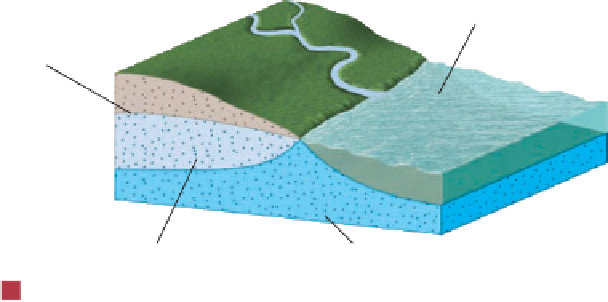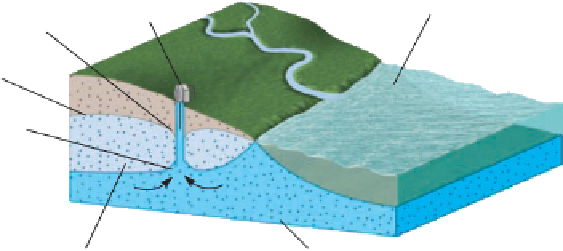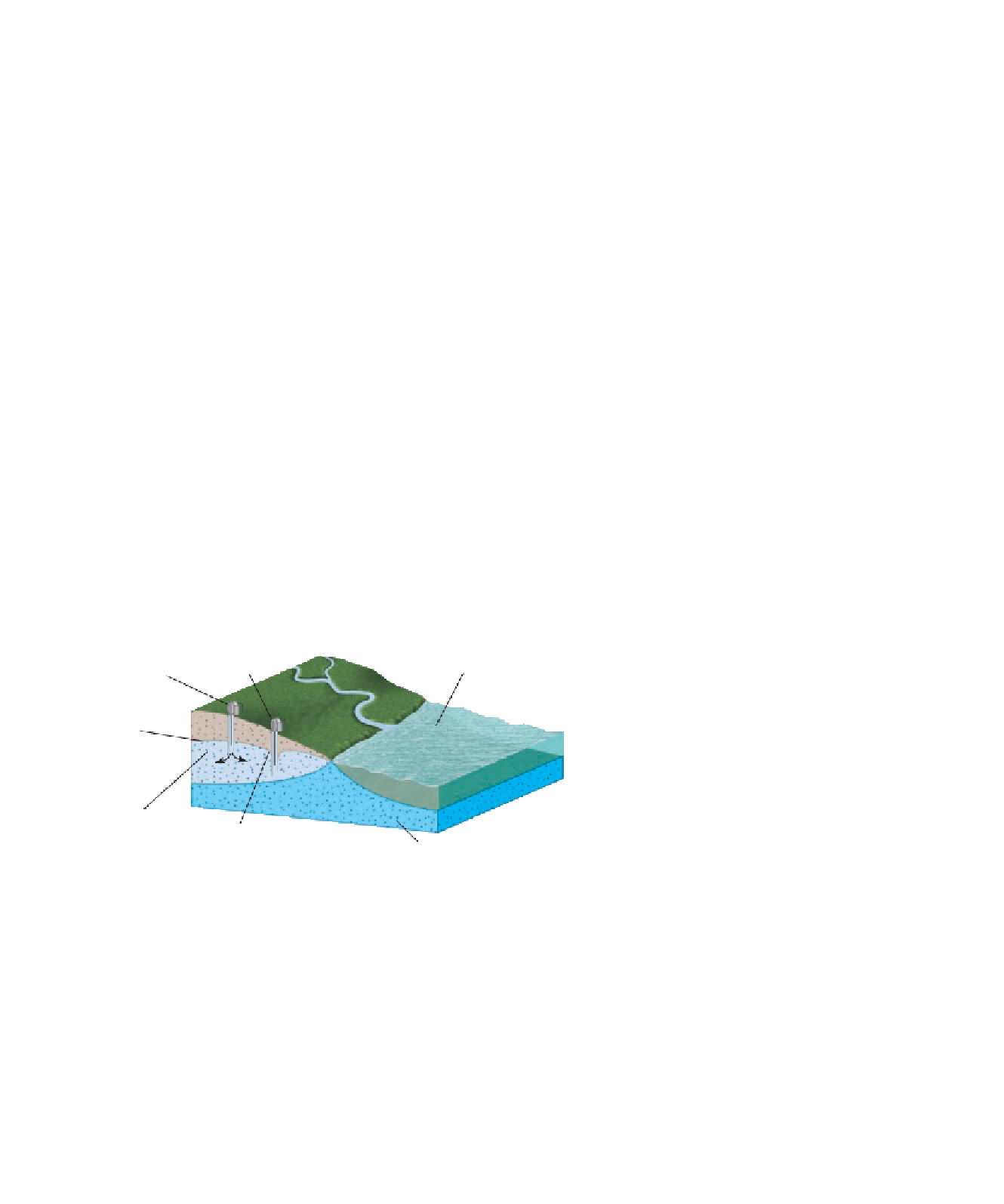Geology Reference
In-Depth Information
As excessive amounts of groundwater are with-
drawn from poorly consolidated sediments and
sedimentary rocks, the water pressure between
grains is reduced, and the weight of the overlying
materials causes the grains to pack more closely
together, resulting in
subsidence
of the ground. As
more and more groundwater is pumped to meet
the increasing needs of agriculture, industry, and
population growth, subsidence is becoming more
prevalent.
The San Joaquin Valley of California is a major
agricultural region that relies largely on groundwater
for irrigation. Between 1925 and 1977, groundwater
withdrawals in parts of the valley caused subsidence
of nearly 9 m (
◗
Figure 13.14
Saltwater Incursion
Ocean
Water
table
Fresh groundwater
a
Because freshwater is not as dense as saltwater, it forms a lens-shaped
body above the underlying saltwater.
Salty groundwater
Figure 13.15). Other areas in the
United States that have experienced subsidence due
to groundwater withdrawal are New Orleans, Loui-
siana, and Houston, Texas, both of which have sub-
sided more than 2 m, and Las Vegas, Nevada, where
8.5 m of subsidence has taken place (Table 13.2).
Looking elsewhere in the world, the tilt of
the Leaning Tower of Pisa in Italy is partly due to
groundwater withdrawal (
◗
Cone of
depression
Pumping
well
Ocean
Water
table
Cone of
ascension
◗
Figure 13.16). The
tower started tilting soon after construction be-
gan in 1173 because of differential compaction of
the foundation. During the 1960s, the city of Pisa
withdrew ever-larger amounts of groundwater,
causing the ground to subside further; as a result,
the tilt of the tower increased until it was in danger
of falling over. Strict control of groundwater with-
drawal, stabilization of the foundation, and recent
renovations have reduced the amount of tilting to
about 1 mm per year, thus ensuring that the tower
should stand for several more centuries.
A spectacular example of continuing subsid-
ence is taking place in Mexico City, which is built
on a former lake bed. As groundwater is removed
for the increasing needs of the city's 17.8 million
people, the water table has been lowered up to
10 m. As a result, the fi ne-grained lake deposits
are compacting, and Mexico City is slowly and
unevenly subsiding. Its opera house has settled
more than 3 m, and half of the fi rst fl oor is now
below ground level. Other parts of the city have
subsided as much as 7.5 m, creating similar
problems for other structures. The fact that 72% of the city's
water comes from the aquifer beneath the metropolitan area
ensures that problems of subsidence will continue.
The extraction of oil can also cause subsidence. Long
Beach, California, has subsided 9 m as a result of many de-
cades of oil production. More than $100 million in damages
was done to the pumping, transportation, and harbor facilities
in this area because of subsidence and encroachment of the
sea (
Fresh groundwater
Salty groundwater
b
If excessive pumping occurs, a cone of depression develops in the fresh
groundwater, and a cone of ascension forms in the underlying salty groundwater,
which may result in saltwater contamination of the well.
Pumping well
Ocean
Recharge
well
Water
table
Fresh
groundwater
Cone of
depression
Salty groundwater
c
Pumping water back into the groundwater system through recharge wells
can help lower the interface between the fresh groundwater and the salty
groundwater and reduce saltwater incursion.
areas grows, greater demand for groundwater creates an even
greater imbalance between withdrawal and recharge.
To counteract the effects of saltwater incursion,
recharge wells are often drilled to pump water back into the
groundwater system (Figure 13.14c). Recharge ponds that
allow large quantities of fresh surface water to infi ltrate the
groundwater supply may also be constructed. Both of these
methods are used successfully on Long Island to mitigate
the saltwater incursion problem that has persisted for
several decades.
Figure 13.17). Once water was pumped back into the
oil reservoir, thus stabilizing it, subsidence virtually stopped.
◗





Search WWH ::

Custom Search